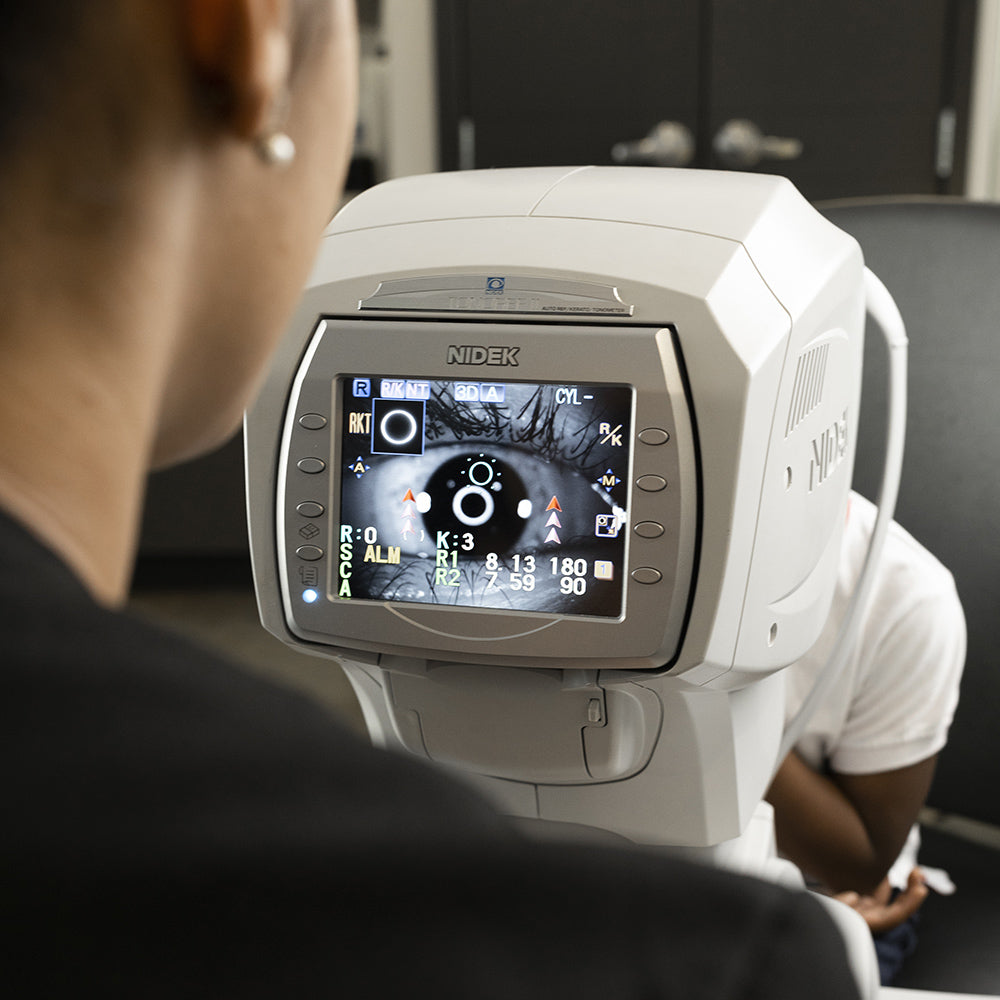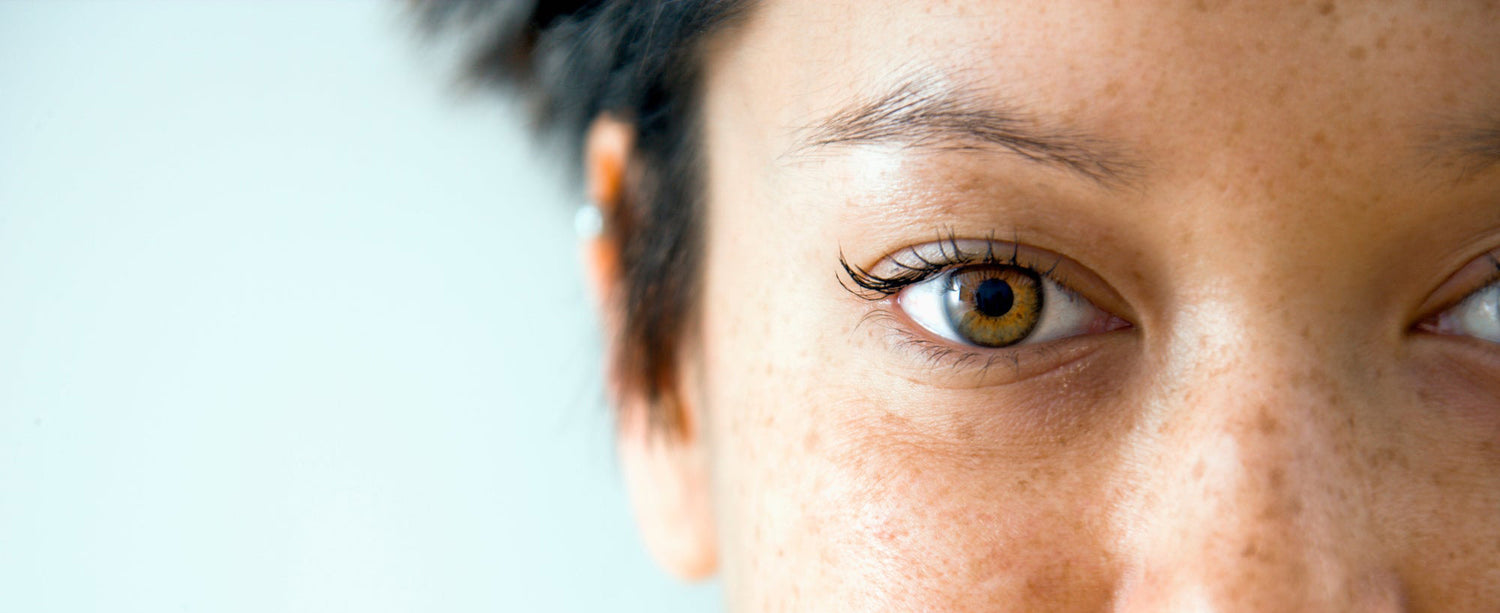Catching problems early.
Many who suffer from common conditions don't exhibit symptoms until the later stages—when they may be too late to reverse.
Your regular eye exams performed by an eye care professional, are your best preventative measure. Problems can be detected early on and treatment can be made a priority.

Learn more about common eye diseases.
Learn more about common eye diseases.
AMD is one of the leading causes of vision loss in both adults and people 65 years or older. It involves the breakdown of the macula of the eye, which is responsible for sharp vision. People with wet AMD may experience blurred vision when trying to see fine details.
That's why it's important for both children and adults, but especially those over the age of 60, to have regular, comprehensive eye exams. This helps detect and treat AMD early, preserving their vision for years to come.
Blepharitis is a common eye condition in which the eyelid becomes inflamed resulting in redness, dryness and a feeling of grit in the eyes.
Usually, blepharitis occurs when tiny oil glands located near the base of your eyelashes become clogged, leading to inflammation and irritation on the surface of the eye and lids. This can happen in isolation, or in combination, with other factors that lead to dry eye disease.
Blepharitis can, however, be difficult to treat. Schedule an appointment with a FYidoctors optometrist if you notice any symptoms.
Cataracts are one of the leading causes of vision loss in people over the age of 40 and remain an uncomfortable side effect of growing older.
Usually painless, cataracts develop as you age and your eyes' lenses naturally begin to harden and turn cloudy or white. The cloudy lens in your eye then blocks light from reaching your retina (the part of your eye that transmits visual information to your brain). The result is a reduction in vision—not unlike looking through a dirty car windshield.
While cataracts often occur naturally as you age, you're more likely to develop them if you have diabetes and hypertension, are obese, a regular smoker or have a family history of the condition.
Getting cataracts treated early on is essential to maintaining proper vision. Schedule an exam on a regular basis if you notice any symptoms.
Computer Vision Syndrome is one of the most common health complications in the workplace. It's caused by staring at a computer screen for extended periods of time. Pixelated images cause your eyes to constantly refocus on different objects resulting in eyestrain, blurred vision, headaches, neck and back pain.
Avoiding Computer Vision Syndrome is simple if you follow a few guidelines from your eye doctor. We offer lenses that are specifically designed for computer use. They can help improve your vision and eliminate eyestrain.
If you have Type 1 or Type 2 diabetes, you may be at risk of diabetic retinopathy, one of the leading causes of blindness among North American adults.
The disease is caused by changes in the blood vessels of the retina (the part of your eye that transmits visual information to your brain). In some cases, blood vessels may swell and leak fluid. In other cases, abnormal new blood vessels may grow on the surface of your retina.
If you suffer from diabetes, you may have diabetic retinopathy and not even know it. Symptoms often go undetected at first, but they gradually worsen and result in vision loss and even blindness in one or both eyes.
There is currently no cure for diabetic retinopathy, but the disease can be treated and its symptoms slowed and managed if caught early. If you have diabetes, you should schedule an eye exam every year.
Up to 29% of Canadians suffer from Dry Eye Disease, a condition that can cause red eyes, affect vision, comfort, and overall ocular health. With the rise in digital technology usage, such as smartphones, a growing number of younger people are also experiencing these issues. Eye drops, recommended by an eye care professional, can help alleviate the symptoms of Dry Eye Disease and improve ocular health. Regular eye exams and prompt treatment are crucial in preserving and enhancing one's vision.
Learn more about the causes, risks and symptoms of Dry Eye Disease and how FYidoctors can help you find relief.
Eye floaters and flashes are small moving spots that may appear in your field of vision and are particularly noticeable when you look at bright lights or single colour objects (such as a piece of white paper or the sky).
While eye floaters can be incredibly annoying, they generally don't interfere with your sight and many people learn to live with them. The condition often improves over time.
Eye floaters can, however, be indicative of a more serious condition, particularly if they're accompanied by sudden flashes of light or a sudden loss of peripheral vision. If you experience these symptoms, or want to learn more about eye floaters and flashers, you should book an eye exam.
Glaucoma is a serious eye condition that damages the optic nerve, potentially leading to permanent loss of vision. It can be inherited and may not present symptoms until later in life, making it important for children and adults to undergo regular eye exams. The National Eye Institute recommends yearly eye exams for those over the age of 40 who have health problems like diabetes or a family history of glaucoma. During the exam, an eye care professional can monitor for symptoms like night blindness, light sensitivity, and issues with central vision, and prescribe eye drops or corrective lenses like eyeglasses or contacts to protect and improve vision.
1 in 1,000 people are likely to suffer from this degenerative eye disease. Teenagers are most at risk.
Keratoconus is a slowly occurring, progressive eye disease in which the normally round cornea (the clear outer part of the eye) thins and begins to bulge into a cone. It then bends the light as it enters the eye and results in blurred vision. While the exact cause of the disease remains unknown, many doctors suspect that it is due to a combination of genetics and environmental conditions.
Early detection is key in minimizing the more severe symptoms of the disease.
Strabismus, commonly known as crossed eyes, and amblyopia, often referred to as lazy eye, are two distinct but related vision conditions that can significantly impact a person’s quality of life. Strabismus occurs when the eyes do not align properly, causing one eye to turn in a different direction from the other. This misalignment can lead to double vision and challenges with depth perception. Amblyopia, on the other hand, typically arises when one eye is weaker than the other, resulting in the brain favoring the stronger eye. Over time, this can cause the weaker eye to lose visual acuity.
At FYidoctors, we understand the profound emotional and psychological impact these conditions can have, especially on children. Our compassionate team is committed to providing personalized care, using the latest diagnostic tools and treatment options to help patients achieve the best possible outcomes. Whether through corrective lenses, vision therapy, or surgical intervention, FYidoctors is here to support you or your loved one on the journey to clearer, more aligned vision.
Learn more about common eye diseases.
Myopia, or nearsightedness, is the struggle to see distant objects clearly. Though common, if untreated it can lead to serious health effects later in life.
Your retina is located at the back of your eye and is responsible for focusing on objects and transmitting visual information to your brain. Retinal detachment is an extremely serious disorder in which your retina actually peels away from the underlying layers of tissue that hold it in place. In most cases, this is caused by other vision problems or a serious injury in or around your eye. Without immediate treatment by an eyecare professional, retinal detachment can lead to vision loss and even blindness.
If you think you may have a retinal detachment, contact us immediately.
The vitreous is the fluid that makes up the majority of the inside of your eye. As you age, your vitreous may decrease in volume, pulling on your retina at the same time. This is known as vitreous detachment and can result in a possible retinal tear, leading to a loss of vision and even blindness.
Your FYidoctors optometrist can examine the fluid in your eye and determine whether or not you're at risk of developing this serious condition—particularly if you're over the age of 60.



